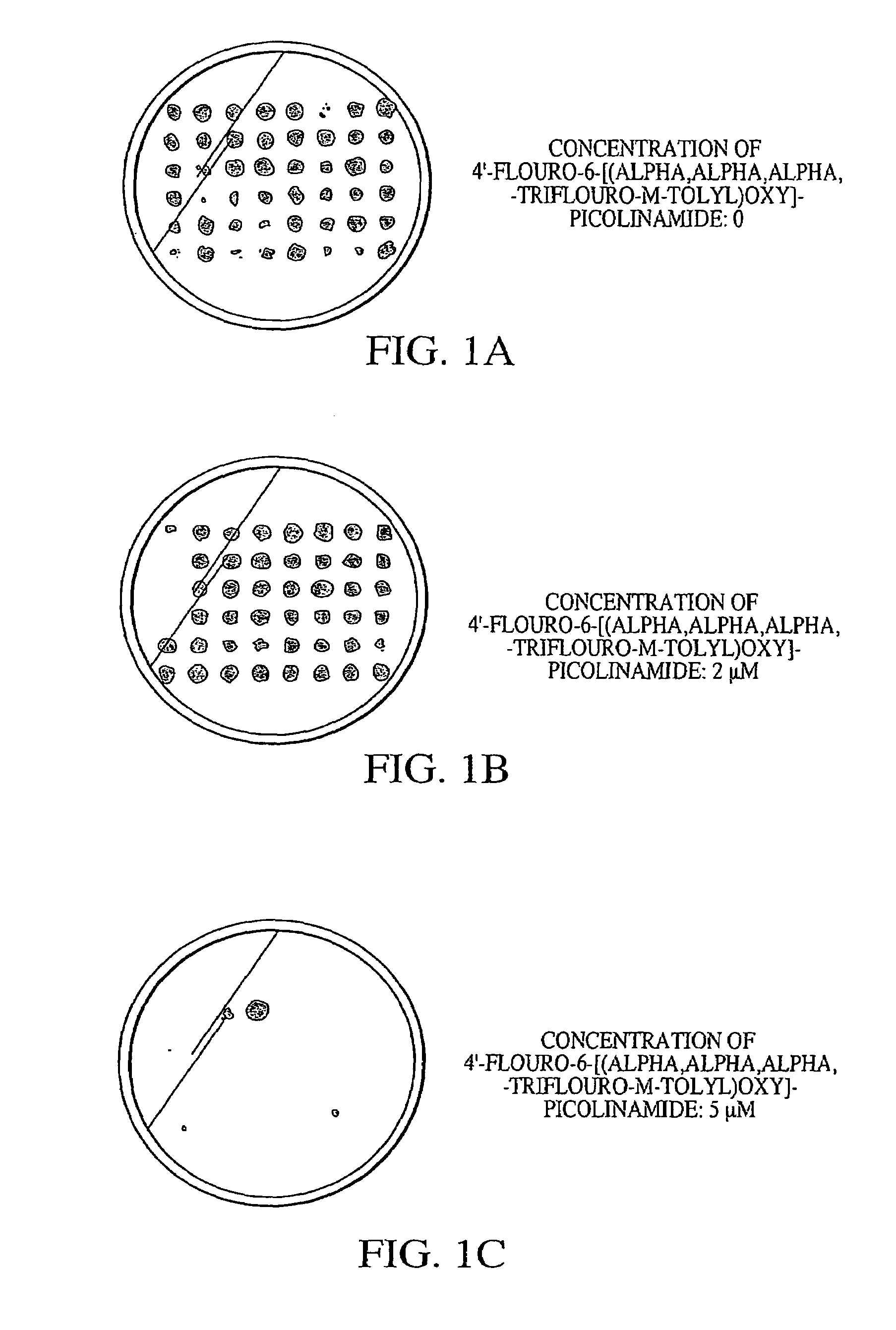Cyanobacterial nucleic acid fragments encoding proteins useful for controlling plant traits via nuclear or plastome transformation
a technology of cyanobacteria and nucleic acid fragments, which is applied in the direction of lyases, transferases, peptides, etc., can solve the problem of observed bleaching symptoms
- Summary
- Abstract
- Description
- Claims
- Application Information
AI Technical Summary
Benefits of technology
Problems solved by technology
Method used
Image
Examples
example 1
Cyanobacterial Screening Process
[0053]Rapid plate based assay for screening lead compounds was developed as follows. First, either one of two types of bluegreen algae, Synechocystis PCC 6803 and Anabaena PC 7120 were grown in microtitre dishes containing BG-11 supplemented with various concentrations of 160 different test compounds. Alternatively, screens can be performed on agar plates with lawns of cyanobacteria and paper discs impregnated with test compounds.
[0054]Susceptibility of Synechocystis to 4′fluoro-6-[(alpha,alpha,alpha,-trifluoro-m-tolyl)oxy]-picolinamide was tested using a paper disc assay in which 4′ fluoro-6-[(alpha,alpha,alpha,-trifluoro-m-tolyl)oxy]-picolinamide was spotted in a paper disc before being placed on a lawn of cells. In determining susceptability, the size of the zone of inhibition is indicative of the potency of the compound.
[0055]These experiments also established a dose-response curve. A lethal concentration for resistant mutant selection was 1–2 μM ...
example 2
Isolation and Selection of Mutant PDS Genes
[0069]100–200 ml of logarithmic liquid culture was harvested and treated with mutagen ethyl methanesulfonate (EMS) in a phosphate buffer. To quench excessive EMS, the reaction was stopped with the addition of sodium thiosulfate to a final concentration of 5%. Cells were collected and washed twice with BG-11, then placed in a fresh BG-11 medium for overnight recovery.
[0070]The cells were then plated on a solid BG-11 medium containing 1 μM 4′fluoro-6-[(alpha,alpha,alpha,-trifluoro-m-tolyl)oxy]-picolinamide. Surviving colonies were cultured in BG-11 within 96-well microtiter plates.
[0071]To identify true mutants, cells were replica plated on BG-11 plates containing 0, 2 or 5 μM 4′fluoro-6-[(alpha,alpha,alpha,-trifluoro-m-tolyl)oxy]-picolinamide, after 2–4 days growth.
[0072]A result from one set of figure plates is shown in FIGS. 1A, 1B and 1C. As the concentration of 4′fluoro-6-[(alpha,alpha,alpha,-trifluoro-m-tolyl)oxy]-picolinamide was incre...
example 3
Cloning and Subcloning of Mutant PDS Gene
[0078]Cloning of the mutant pds genes went as follows. A pair of primers were designed to amplify the pads gene using Synechocystis DNA prepared from wild type and 4′fluoro-6-[(alpha,alpha,alpha,-trifluoro-m-tolyl)oxy]-picolinamide resistant mutant cells as templates.
[0079]PDS genes were cloned from wild type Synechocystis and 4′fluoro-6-[(alpha,alpha,alpha,-trifluoro-m-tolyl)oxy]-picolinamide resistant cell lines. Synechocystis genes were cloned from cell lines by a PCR based strategy. Genomic DNA was used as a template. Based on sequence information available in a database, the following primers were used (from 5′ to 3′): X62574-5′ cgaattccctggtagcatttaatacaattggc, SEQ ID NO: 1, and X62574-3′ cgcataagctttgcagatggagacggtttgggc, SEQ ID NO: 2.
[0080]A 1.7 Kb PCR fragment was obtained and subsequently subcloned into Invitrogen TOPO TA vector, resulting in plasmids TOPO TA-PDS (PDSr). PCR products were subcloned into an Invitrogen TOPO TA cloning...
PUM
| Property | Measurement | Unit |
|---|---|---|
| Electrical resistance | aaaaa | aaaaa |
Abstract
Description
Claims
Application Information
 Login to View More
Login to View More - R&D
- Intellectual Property
- Life Sciences
- Materials
- Tech Scout
- Unparalleled Data Quality
- Higher Quality Content
- 60% Fewer Hallucinations
Browse by: Latest US Patents, China's latest patents, Technical Efficacy Thesaurus, Application Domain, Technology Topic, Popular Technical Reports.
© 2025 PatSnap. All rights reserved.Legal|Privacy policy|Modern Slavery Act Transparency Statement|Sitemap|About US| Contact US: help@patsnap.com



